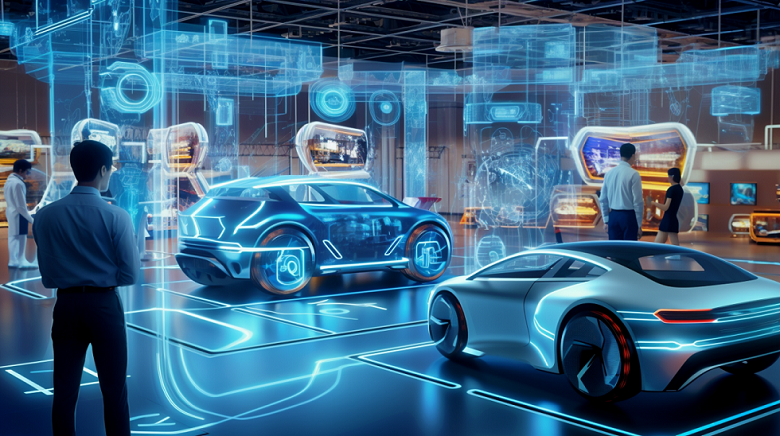It is anticipated that V2V technology will surpass present car safety measures in terms of advancement.
Artificial Intelligence (AI) has become a game changer in the dynamic field of transportation, especially in the area of Vehicle-to-Vehicle (V2V) communication.
It is expected that V2V technology will surpass existing car safety features such as backup cameras, adaptive cruise control, blind spot recognition, and rear parking sensors. By giving a thorough knowledge of all threats surrounding the vehicle, it increases safety. At first, it will warn the driver of possible hazards but won’t take direct control of the vehicle’s motion to prevent collisions. It may improve the braking and steering systems in the future to give the driver complete control over the vehicle’s movements.
The increasing popularity of smart automobiles has led to a lot of discussion regarding connected and communicative vehicles. However, what relevance does artificial intelligence (AI) have to any of this? This essay will examine how artificial intelligence is transforming automobile connectivity and communication.
Vehicle to Vehicle (V2V): What is it?
Vehicle-to-vehicle (V2V) communication technology helps prevent auto accidents. It functions via a system known as VANETs, which is akin to a specialized wireless network that enables communication between automobiles. They provide information about their driving style, including speed, location, braking, and stability. This reduces the likelihood of accidents by alerting drivers to them before they even notice them.
Cars may transmit and receive messages via a wireless network using V2V. Even if drivers aren’t paying careful attention, these messages can gather information about traffic conditions several miles in advance, providing them enough time to adapt their driving. The International Organization for Standardization (ISO) and the Federal Communication Commission (FCC) have adopted the dedicated short-range communications (DSRC) standard, which is used by this technology. In addition to V2V, there’s V2I, which links cars to other roadside devices and fixtures like traffic lights.
AI’s Role in V2V Communication
- Increasing the Bar for Safety Standards
Transportation is fundamentally about safety, and AI-powered V2V communication has great potential to support this important component. Vehicles can share critical data in real-time, including position, speed, and trajectory, by utilizing AI algorithms. This makes it easier to take a proactive approach to lowering possible hazards by enabling cars to recognize and react to threats quickly, which lowers the likelihood of accidents.
Furthermore, AI algorithms can examine large datasets to find trends and abnormalities, which enables cars to anticipate dangerous circumstances such as abrupt braking or lane changes. By enabling autonomous evasive maneuvers, this proactive approach to safety reduces the risk of crashes and guarantees the protection of both pedestrians and vehicle occupants.
- Enhancing Traffic Management
One of the most enduring problems in metropolitan environments is traffic congestion, which results in lost time, fuel, and increased carbon emissions. A workable answer is provided by AI-driven V2V communication, which optimizes traffic flow by cleverly coordinating and synchronizing vehicle movements.
Through the facilitation of information sharing on traffic conditions, road closures, and alternative routes, cars can dynamically modify their speeds and routes to avoid crowded areas. This reduces traffic congestion and improves traffic efficiency overall. AI algorithms can also make lane changes and merging more fluid, which reduces interruptions and promotes a smooth traffic flow.
- Enhancing autonomous mobility
The development of AI-powered V2V communication is essential to the advancement of autonomous driving technologies. As autonomous driving grows more sophisticated, real-time data sharing between vehicles and adjacent vehicles becomes essential for secure and effective operation.
The ability of autonomous vehicles to comprehend and react to the wide range of inputs they get from other vehicles is made possible in large part by AI algorithms. Artificial Intelligence enables autonomous systems to navigate the roads with confidence and accuracy, from anticipating the actions of oncoming vehicles to planning complex manoeuvres like lane changes and intersection crossings.
- Encouraging the Integration of Intelligent Infrastructure
AI not only promotes communication between vehicles but also makes it easier to integrate smart infrastructure elements like road signs, traffic signals, and pedestrian crossings. Vehicles can communicate with infrastructure components to prioritize emergency vehicles, improve pedestrian safety, and optimize traffic light timings by utilizing artificial intelligence algorithms.
AI also gives cars the ability to read and react to traffic signs and signals, adding another level of direction and situational awareness. The foundation is laid for a linked transportation environment that is responsive, adaptable, and intrinsically safer through the integration of AI-driven V2V communication with smart infrastructure.
The Way Ahead
Artificial Intelligence is starting to play a bigger role in how cars communicate and connect. It’s evident that AI now plays a significant role in the auto sector. AI has made driving safer for everyone by enabling cars to communicate with their surroundings and use data to make informed decisions. V2V technology is now primarily in the experimental phase. Numerous test versions are being tested in automobiles. Certain test versions have shown promise in providing cars with sufficient warning to steer clear of hazards and navigate them safely. We could expect to see increasingly more intelligent methods for cars to connect and converse in the future as AI advances.












